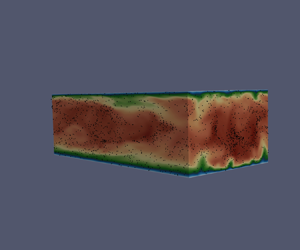Article contents
The discrete Green's function paradigm for two-way coupled Euler–Lagrange simulation
Published online by Cambridge University Press: 18 November 2021
Abstract

We outline a methodology for the simulation of two-way coupled particle-laden flows. The drag force that couples fluid and particle momentum depends on the undisturbed fluid velocity at the particle location, and this latter quantity requires modelling. We demonstrate that the undisturbed fluid velocity, in the low particle Reynolds number limit, can be related exactly to the discrete Green's function of the discrete Stokes equations. In addition to hydrodynamics, the method can be extended to other physics present in particle-laden flows such as heat transfer and electromagnetism. The discrete Green's functions for the Navier–Stokes equations are obtained at low particle Reynolds number in a two-plane channel geometry. We perform verification at different Reynolds numbers for a particle settling under gravity parallel to a plane wall, for different wall-normal separations. Compared with other point-particle schemes, the Stokesian discrete Green's function approach is the most robust at low particle Reynolds number, accurate at all wall-normal separations. To account for degradation in accuracy away from the wall at finite Reynolds number, we extend the present methodology to an Oseen-like discrete Green's function. The extended discrete Green's function method is found to be accurate within  $6\,\%$ at all wall-normal separations for particle Reynolds numbers up to 24. The discrete Green's function approach is well suited to dilute systems with significant mass loading and this is highlighted by comparison against other Euler–Lagrange as well as particle-resolved simulations of gas–solid turbulent channel flow. Strong particle–turbulence coupling is observed in the form of turbulence modification and turbophoresis suppression, and these observations are placed in context of the different methods.
$6\,\%$ at all wall-normal separations for particle Reynolds numbers up to 24. The discrete Green's function approach is well suited to dilute systems with significant mass loading and this is highlighted by comparison against other Euler–Lagrange as well as particle-resolved simulations of gas–solid turbulent channel flow. Strong particle–turbulence coupling is observed in the form of turbulence modification and turbophoresis suppression, and these observations are placed in context of the different methods.
- Type
- JFM Papers
- Information
- Copyright
- © The Author(s), 2021. Published by Cambridge University Press
References
REFERENCES
- 9
- Cited by





